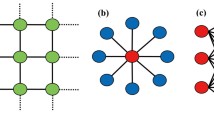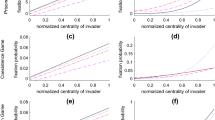Abstract
The modeling and analysis of large networks of autonomous agents is an important topic with applications in many different disciplines. One way of modeling the development of such networks is by means of an evolutionary process. The autonomous and selfishly acting agents are randomly chosen to become active according to an underlying probability distribution. They may apply some kind of local mutation operator to the network and decide about accepting these changes via some fitness-based selection whereas the fitness models the agent’s preferences. This general framework for the self-organized evolution of networks can be instantiated in many different ways. For interesting instances, one would like to know whether stable topologies eventually evolve and how long this process may take. Here, known results for an instantiation based on random spanning trees and a fitness-based selection according to global graph centrality measures are improved. Moreover, a more natural and local fitness-based selection using only the information on nearest neighbors is presented and analyzed with respect to the expected time needed to reach a stable state.
Similar content being viewed by others
References
Agnarsson, G., Deo, N., Micikevicis, P.: On the expected number of level-i-nodes in a random labeled tree. Bull. ICA 41, 51–60 (2004)
Anshelevich, E., Dasgupta, A., Tardos, E., Wexler, T.: Near-optimal network design with selfish agents. In: ACM Symposium on Theory of Computing (STOC’03), pp. 511–520 (2003)
Anshelevich, E., Dasgupta, A., Kleinberg, J., Tardos, E., Wexler, T., Roughgarden, T.: The price of stability for network design with fair cost allocation. In: IEEE Symposium on Foundations of Computer Science (FOCS’04) (2004)
Bala, V., Goyal, S.: A noncooperative model of network formation. Econometrica 68, 1181–1230 (2000)
Brémaud, P.: Markov Chains, Gibbs Fields, Monte Carlo Simulation, and Queues. Springer, Berlin (1998)
Entringer, R.C., Meir, A., Moon, J.W., Székely, L.: On the wiender index of trees from certain families. Australas. J. Combin. 10, 211–224 (1994)
Fabrikant, A., Luthra, A., Maneva, E., Papadimitriou, C.: On a network creation game. In: Symposium on Principles of Distributed Computing (PODC’03), pp. 347–351 (2003)
Fischermann, M., Hoffmann, A., Rautenbach, D., Szekely, L., Volkmann, L.: Wiener index versus maximum degree in trees. Discrete Appl. Math. 122, 127–137 (2002)
Garnier, J., Kallel, L., Schoenauer, M.: Rigorous hitting times for binary mutations. Evol. Comput. 7(2), 173–203 (1999)
Jansen, T., Theile, M.: Stability in the self-organized evolution of networks. In: Lipson, H. (ed.) Conference on Genetic and Evolutionary Computation (GECCO’07), pp. 931–938. Assoc. Comput. Mach., New York (2007)
Janson, S.: The wiener index of simply generated random trees. Random Struct. Algorithms 22(4), 337–358 (2003)
Jordan, M.E.C.: Sur les assemblages des lignes. J. Reine Angew. Math. 70, 185–190 (1869)
Lehmann, K., Kaufmann, M.: Evolutionary algorithms for the self-organized evolution of networks. In: Conference on Genetic and Evolutionary Computation (GECCO’05), pp. 563–570 (2005)
Luczak, T.: The height of a random tree. Technical report, Adam Mickiewicz University (1993)
Mitzenmacher, M., Upfal, E.: Probability and Computing. Cambridge University Press, Cambridge (2005)
Motwani, R., Raghavan, P.: Randomized Algorithms. Cambridge University Press, Cambridge (1997)
Papadimitriou, C.H.: Algorithms, games, and the Internet. In: ACM Symposium on Theory of Computing (STOC’01). Lecture Notes in Computer Science, vol. 2076, pp. 1–5. Springer, Berlin (2001)
Prüfer, H.: Neuer Beweis eines Satzes über Permutationen. Archiv für Mathematik und Physik, pp. 142–144 (1918)
Renyi, A., Szekeres, G.: On the height of trees. J. Aust. Math. Soc. 7, 497–507 (1967)
Rojas, R.: Neural Networks. Springer, Berlin (1996)
Williams, D.: Probability with Martingales. Cambridge Mathematical Textbooks (1991)
Author information
Authors and Affiliations
Corresponding author
Rights and permissions
About this article
Cite this article
Theile, M., Jansen, T. Stability in the Self-Organized Evolution of Networks. Algorithmica 57, 147–169 (2010). https://doi.org/10.1007/s00453-008-9242-7
Received:
Accepted:
Published:
Issue Date:
DOI: https://doi.org/10.1007/s00453-008-9242-7




